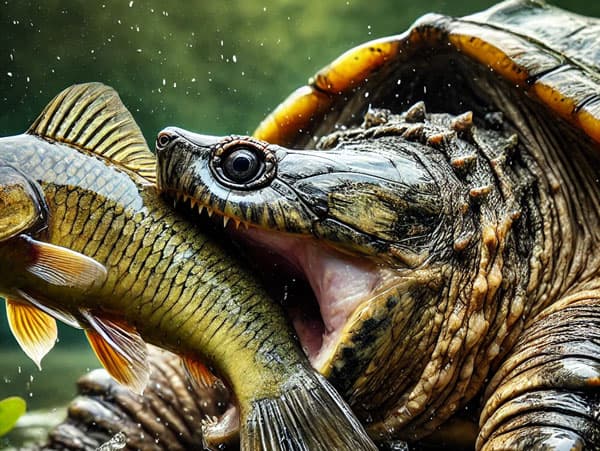What Do Snapping Turtles Eat?
Snapping turtles are fascinating creatures, known for their powerful jaws and unique dietary needs. Whether you’re a pet owner or just curious about these reptiles, understanding what snapping turtles eat is essential. This guide covers everything from their natural diet in the wild to their feeding habits in captivity, ensuring you have all the information you need.

Understanding Snapping Turtles and Their Habitat
Snapping turtles are primarily freshwater turtles that can be found in a variety of habitats, including ponds, lakes, swamps, and slow-moving rivers. There are two main species: the common snapping turtle (Chelydra serpentina) and the alligator snapping turtle (Macrochelys temminckii). These turtles are known for their aggressive disposition when threatened but are generally quite reclusive.
In the wild, snapping turtles play a crucial role in their ecosystem. They are both predators and scavengers, consuming a wide range of food that helps keep their environment balanced. Their habitats usually have muddy bottoms, plenty of vegetation, and ample hiding spots, which are essential for their hunting techniques. During winter months, snapping turtles hibernate in the mud to survive the cold temperatures.
One fascinating aspect of snapping turtle behavior is their migratory patterns. They often travel significant distances to find suitable nesting sites or to access seasonal food sources. Understanding their habitat is crucial to grasping their dietary needs.
What Do Snapping Turtles Eat?
Fish and Aquatic Invertebrates: Fish make up a significant portion of their diet. They also eat a variety of aquatic invertebrates like crayfish, snails, and insects.
Amphibians and Small Reptiles: Frogs, tadpoles, small snakes, and other reptiles often fall prey to snapping turtles. They are opportunistic feeders, which makes their diet quite diverse.
Birds and Small Mammals: On rarer occasions, they have been known to capture and consume birds and small mammals. This typically happens when such prey is vulnerable.
Plants and Algae: While they are primarily carnivorous, snapping turtles do consume plant matter. Aquatic plants and algae form a part of their diet, especially when animal prey is scarce.
Carrion: Snapping turtles are scavengers and will eat carrion. This helps break down dead animals in their ecosystem, contributing to the ecological balance.
Snapping turtles are most active during dusk and dawn when they hunt for food. Their diet adaptability is one of their major survival traits, allowing them to thrive in various environments.
What Do Snapping Turtles Eat in Captivity?
Feeding snapping turtles in captivity requires carefully mimicking their natural diet to ensure they receive balanced nutrition. Captive snapping turtles often have more predictable feeding routines compared to their wild counterparts.

1.Commercial Turtle Pellets: These are specially formulated to provide the necessary nutrients. They should form a good base for their diet.
2.Fresh Fish and Meat: Small pieces of fish, chicken, or even beef heart can be offered. Be sure to remove any bones to prevent choking.
3.Vegetables and Fruits: Leafy greens like romaine, spinach, and aquatic plants are excellent choices. Occasional fruits like berries can be offered, but should not be a staple.
4.Live Prey: Introducing live prey like minnows or insects can stimulate natural hunting behavior and provide enrichment.
5.Calcium Supplements: To ensure proper shell development, calcium supplements should be added to their diet. A calcium block can also be placed in their tank.
Feeding should be done in a shallow dish or a separate container to prevent water contamination. Ensure that uneaten food is removed promptly to maintain clean water conditions.
How Often to Feed Snapping Turtles?
Feeding frequency for snapping turtles varies depending on their age and size. Providing the right amount of food at appropriate intervals is crucial for their health and well-being.
Hatchlings and Juveniles: These young turtles have higher energy needs. They should be fed daily with a diet rich in protein to support their rapid growth.
Young Adults: As snapping turtles mature, their metabolism slows down. Feeding them every other day ensures they get enough nutrition without overfeeding.
Adults: Mature snapping turtles can be fed two to three times a week. Excessive feeding can lead to obesity, so it’s important to monitor their weight and adjust feeding schedules accordingly.
Feeding Tips: Always observe your turtle’s behavior. If they seem lethargic or refuse food, there might be an underlying issue that needs addressing. Providing a varied diet will keep them interested and ensure they receive different nutrients.
Conclusion
Understanding what snapping turtles eat and their feeding habits provides valuable insights into their care and role in the ecosystem. Whether they are in the wild or in captivity, snapping turtles require a balanced diet to thrive. By mimicking their natural diet and feeding schedules, you can ensure their well-being and longevity.
FAQs
What is a snapping turtle’s favorite food?
Snapping turtles, like many animals, don’t have a single favorite food. However, they are highly fond of fish and other aquatic animals because of their availability and nutritional value.
Can snapping turtles eat lettuce?
Yes, snapping turtles can eat lettuce, but it should not be a major part of their diet. Opt for more nutritious leafy greens such as kale or spinach instead.
What to do if you find a snapping turtle in your yard?
If you find a snapping turtle in your yard, it’s best to leave it alone. They may be passing through or looking for a nesting site. If it’s in danger, gently guide it back towards a water source using a shovel or stick.
